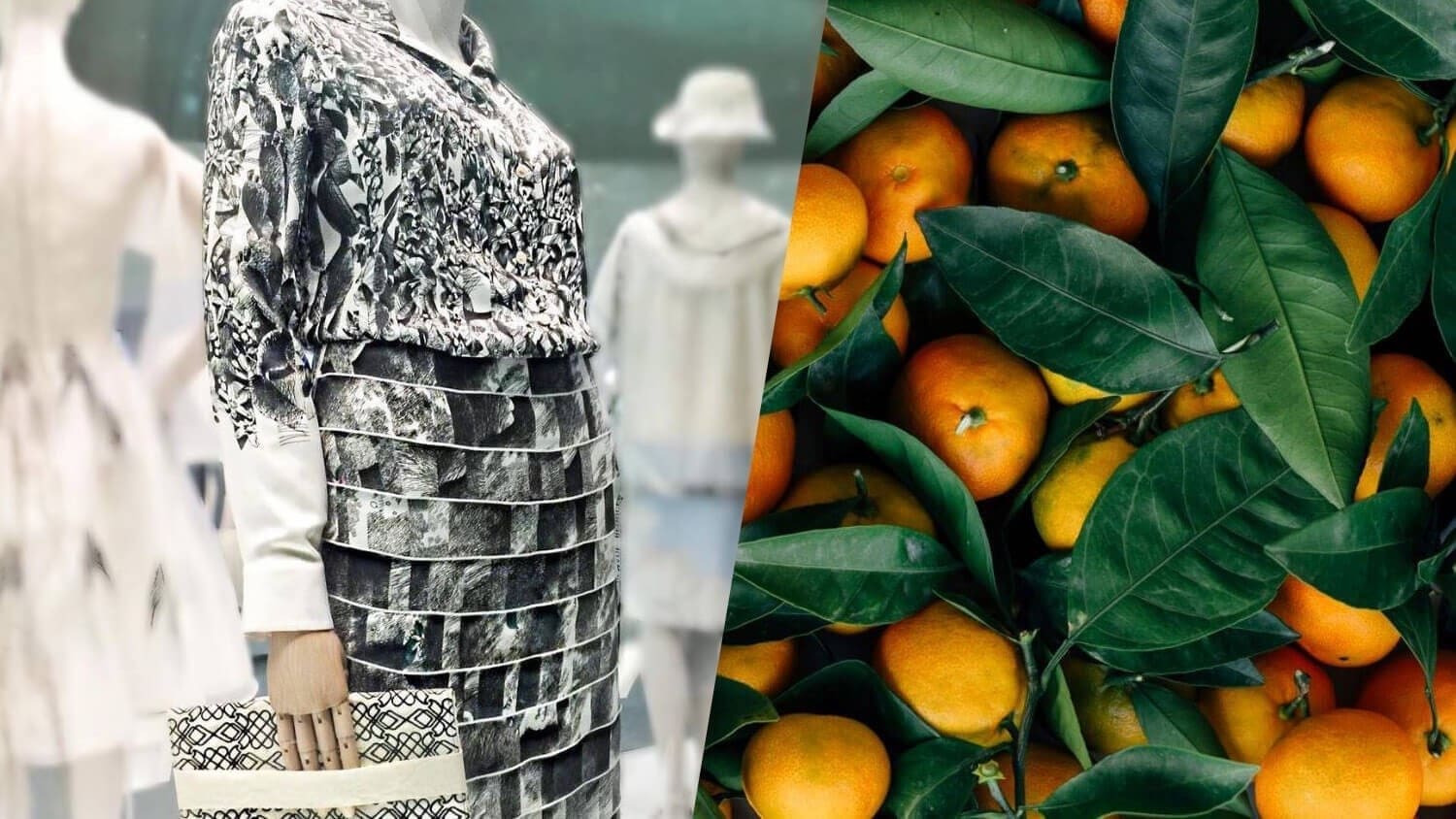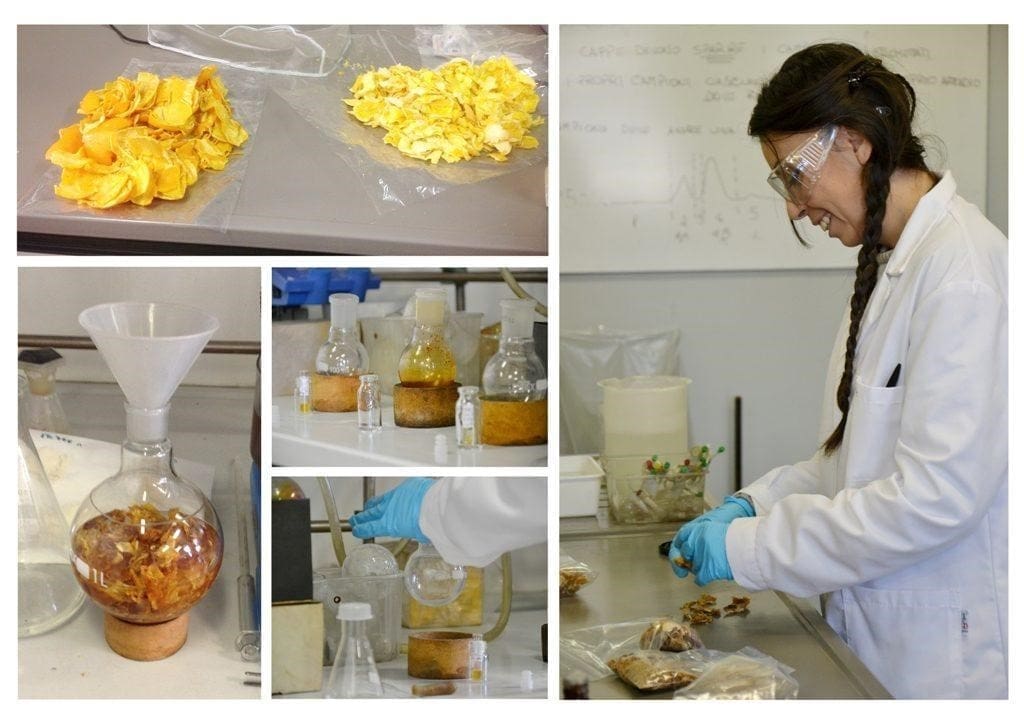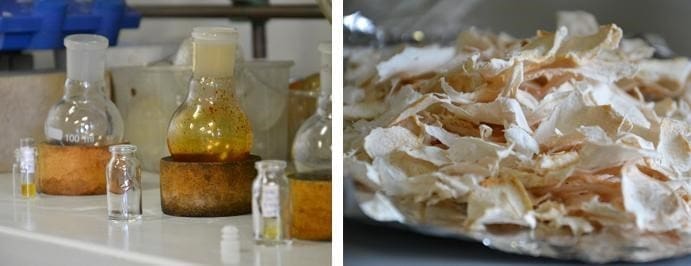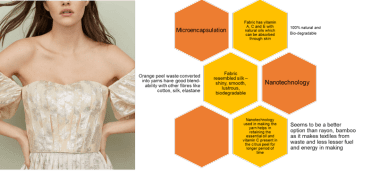ORANGE FIBER-THE FABRIC FROM FRUIT
Introduction

Image no 1 – Salvatore Ferragamo Collection using Orange Fiber
Textile fibres could be made from natural and synthetic materials. Natural fibres generally known as could be animal or plant fibres such as silk, mohair, cashmere, cotton, jute, hemp, flax, coir, etc., while synthetic would be nylon, rayon, polyester, etc., which constitute man-made fibres that are manufactured by artificial processes. There have been others, like banana fibres, from the plant but heavily processed to make them usable to weave cloth. One of the latest to join the bandwagon is orange fibre, made from waste material or the peel of the orange.
Orange Fiber is the first patented material made from citrus juice by-products. Citrus fruits are healthy and tasty, and the worldwide production of oranges is steadily increasing. However, in the citrus fruit industry, processing that float, for example to make it into juices, also generates huge amounts of waste. Lightweight Citrus cellulose yarn can be used in its entirety to make a 100% citrus biodegradable fabric that is soft, silky, and lightweight.
It can also be blended with other materials and be opaque or shiny according to the designer’s needs.The fibre is made through a process that was innovated in collaboration with Politecnico di Milano University. [2]
Current Uses of Orange Peel Waste
- Oil Extraction
- Dyeing
- Antimicrobial finishing
- Mosquito repellent finish
- Print transfer medium
- Water purification
- Textile effluent waste
- Bio-adsorbent
- Biogas
- Bio-char [3]
The Process

Image No 2 – Process of Making Orange Fiber

Image no 3 – Fruit to Fiber
- The peels are processed with a patented method to extract the cellulose that is spun to form the final yarn. The fabric looks and feels like silk: soft to the touch and with a shiny appearance. The biodegradable yarn can be spun with any type of existing yarn.
- Orange Fiber’s patented process breathes new life into the pastazzo, which is an atechnical term for what is left over after squeezing the citrus fruits.
The wet citrus residual, pastazzo, is processed to be able to extract the cellulose that will form the final yarn.
- A biodegradable material like silk is produced: soft to the touch and shiny in appearance, it is suitable to be woven with any type of existing yarn.
Benefits of the orange fiber
- Orange Fiber is created from citrus juice by-products that would otherwise be thrown away. This means that hundreds of thousands of tonnes of orange peels find good use as ethereal fabrics perfectly suited to high-quality textiles and fashion.
- Organic Orange Fiber Fabric is wonderfully soft, cuddly, and strong. It drapes beautifully, is anti-wrinkle, and a plus point is that it comes in lots of ranges and types, e.g., crepe, satin, cotton, etc.
- From the perspective of safeguarding the interests of the environment, the world’s production of waste materials in the form of orange peels exceeds 700 tonnes per year. By utilising this waste productively, it offers a solution.
- While a textile made from food may seem a little unusual at first glance, the idea has environmental and social benefits as well as being a positive addition to the fashion and textile industry. In addition to being good for the environment, the textile is good for the body as well, containing health properties.
- As it is made from citrus, the natural oils within the fabric contain vitamins A, C, and E.
Upon contact, these vitamins are released and absorbed through the skin.
- Aside from looking pretty and feeling nice, the orange yarn has an additional benefit:
thanks to nanotechnology, the material still contains essential oils and vitamin C that are present in the citrus fruit peel.
- The skin absorbs these oils and is nourished by them, making the fabric a wearable body cream. According to Orange Fiber, despite the oils, the fabric does not feel greasy. The oils are guaranteed to last at least twenty washing cycles, but the company is experimenting with recharging methods using special fabric softeners.
- The company made three prototype fabrics. The first is a lace silk in black and white, the second is a cream-colored satin from which clothes such as summer dresses can be made, and the third is a viscose-like fabric from which clothes such as shirts can be made.The citrus peel yarn has won several national and international awards.
- An orange fibre blended with silk provides a silken-feeling thread that looks and functions just like real silk.
- The orange fibre can be dyed, printed, and coloured to create whatever look and feel we want.
- The new vitamin-enriched textile represents a brand new opportunity in high-quality textiles and fashion.

Image no 4 – Orange Fiber process

Image no 5 – Properties of textiles made from orange peel waste
Conclusion
As per the call of the current scenario, sustainable fibers are the need of the hour. Orange Fiber & Fabric is the new development made which is suitable as per the market trends and also sustainability & environmentally friendly. This fiber which has also been used by Well known Designer Salvatore Ferragamo for his collection seems like the fiber of the Present Time. Also these Sustainable fibers are indeed the fibers of the Present & growing Future.
References
- Fabrics from Oranges – interesting and exciting. Retrieved fromhttps://www.unnatisilks.com/blog/fabrics-from-oranges-interesting-and-exciting/
- Future of fashion: Innovative fabric – Orange fibre. Retrieved fromhttps://amberoot.com/blogs/blog/future-of-fashion-innovative-fabric-orange-fibre
- Sachidhanandham S. (2020). Textiles from orange peel waste. Science & TechnologyDevelopment Journal, 23(2):508-516. DOI : 10.32508/stdj.v23i2.1730. Retrieved from https://www.researchgate.net/publication/340927840
- Sheena S. (2019, October 13). Orange Fiber – Sustainable Fashion made of Orange Peel.Retrieved from
https://en.reset.org/blog/orange-fiber-sustainable-fashion-made-orange-peel-10142019
Image References
Image no 1 – Salvatore Ferragamo Collection using Orange Fiber https://www.livekindly.co/italys-orange-fiber-sustainable-vegan-silk-cruelty-free/
Image No 2 – Process of Making Orange Fiber –
https://www.unnatisilks.com/blog/fabrics-from-oranges-interesting-and-exciting/
Image no 3 – Fruit to Fiber –
https://www.linkedin.com/company/orange-fiber-s.r.l./
Image no 4 – Orange Fiber process –
https://www.unnatisilks.com/blog/fabrics-from-oranges-interesting-and-exciting/
Image no 5 – Properties of textiles made from orange peel waste https://www.researchgate.net/publication/340927840
Author:
 ANNU JAIN (Faculty)
ANNU JAIN (Faculty)
Department of Textiles and Apparel Designing, Sir Vithaldas Thackersey College of Home Science (Autonomous), SNDT Women’s University, Mumbai.
